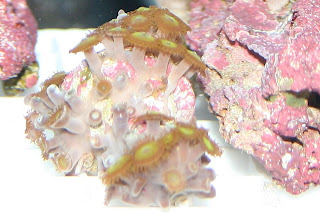With new firmware released yesterday, I worked on updating my Reef Keeper Elite (RKE). I had skipped updating other releases up to this point because Digital Aquatics wasn't providing a fix for the graphing feature. I'll have to wait several hours before I can see if graphing has indeed been fixed.
I should have broken out a notepad to record all the steps that I had to take to finally reach the goal of SUCCESSFUL UPDATE. It would have been hilarious to bore you with the details in order for you to "join me", Lord of the Rings-esque style, on my quest. I'll just bring up a few salient points that have seared themselves into my memory.
First of all, I used to consider myself technically savvy (at least back in 2002), but now I find myself going through stuff I thought I heard about years ago and already forgot. Like the following:
1) Using USB memory keys in Windows 98 usually requires a driver of some sort. So, using that Win98 laptop to do the updates was not an option. But, wait, I could burn the firmware software to a CDROM and transfer it that way.
2) MSI installation file from the CDROM was not understood by Win98. So, go get the other WinVista laptop from upstairs because the old laptop ain't gonna work. During this time, I was also trying to install Firefox after getting the wireless card configured on Win98 laptop, but it was taking too long to download.
3) When someone (or something) installs WinZip onto a Vista computer, the trial ends after 45 days and it doesn't unzip the program from Digital Aquatics. Then, after you uninstall WinZip, WinVista dosen't know how to open zip compressed files. It originally was supposed to do it, though. (and if you associate zip files with IE, you get stuck in a software loop! Delete the file to cut the crap!) I finally tracked down a simple Registry fix.
This sort of troubleshooting can really use up the buzz off of your morning coffee.
I had left my own winXP laptop at work. Things would have been simpler if I wasn't sandwiched between Win98 and WinVista laptops today. The Vista computer finally was able to get the firmware software installed. Now, it was time to update the modules.
When it came time to update the never-before-updated module called the GC1 or "head unit", I had to figure out how to unplug the line.

The data line is buried in the unit with only the flushed precision that a design engineer would be proud of. Unfortunately, I bit off my finger nails the day before, so I had to look for some other sharp instrument to lower the dongle in order to release the line. I found myself having to do this several times while updating because.....
...the updates were not successful on the first attempts. For the GC1, there's a drop down menu for Advanced, but I didn't see any mention of it in Digital Aquatics' instructions. Of course, their instructional PDF is currently named with "v105", so someone is overlooking something somewhere out there. So, I just ran the Advanced option not knowing what I was really doing.
But, what else can you do when the modules don't even power up after your first attempt?
Just keep trying and praying to Poseidon (
or Neptune, one of their competitors).
YES, I PLUGGED THE PROPER WIRE INTO THE PROPER DEVICE WITH THE POWER OFF AND OTHER MODULES UNPLUGGED!
G.D............F!
In addition to having to install the firmware a few times with the head unit, I had to install it a few times with the SL1. I wonder if there was some sort of specific order I was to follow? In the end, my method of re-installing-the-firmware-until-it-works worked.
Now, I'll give it time to show me what it can do. Once I verify graphs are working, I'll try to move over more devices to the RKE's control. Then, someday I may give it my stamp of approval.

























